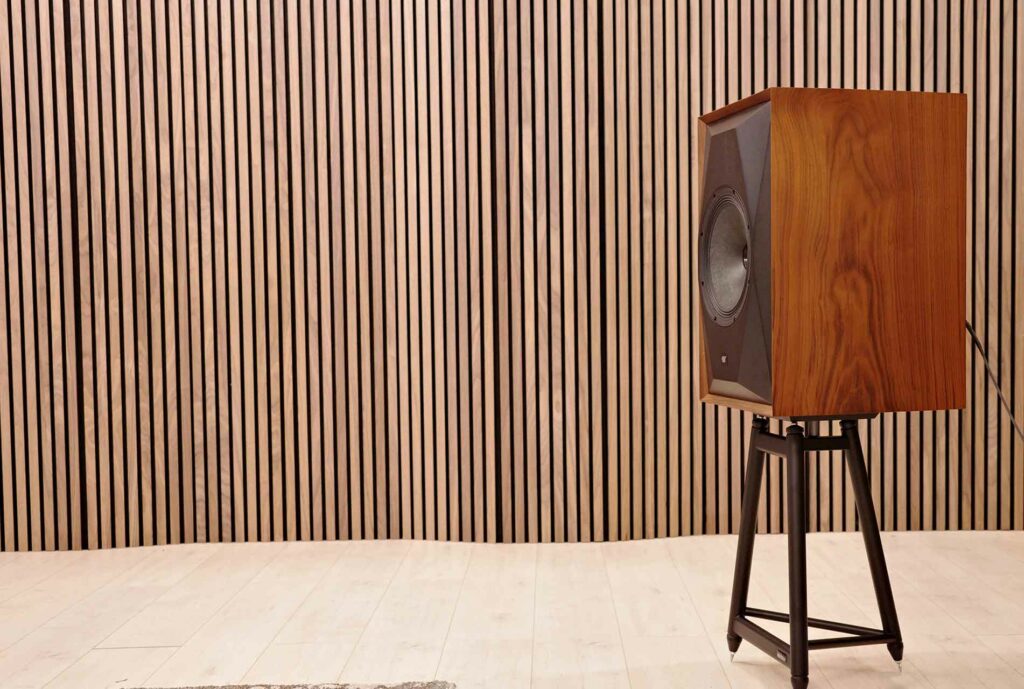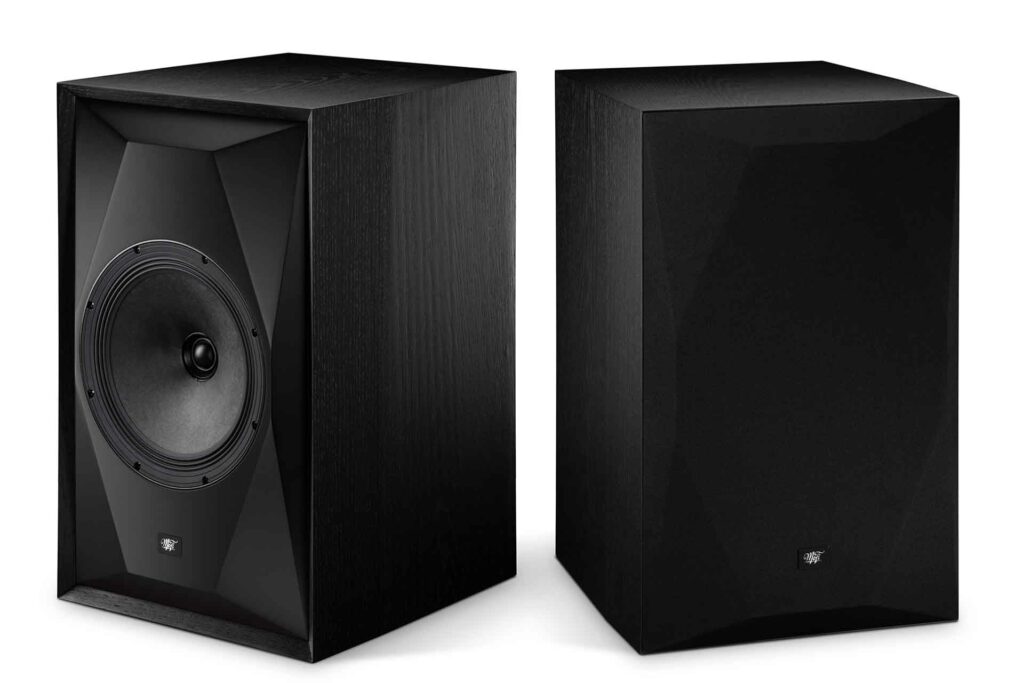
MoFi Electronics introduced its new MoFi SourcePoint 10 loudspeakers (read a review of the Source Point 8 here) at Capital Audiofest in Rockville, MD, U.S.A., running November 11 through November 13. The speakers are the result of 18 months of research and development led by Chief Speaker Designer Andrew Jones. Designed like a cost-no-object loudspeaker, SourcePoint 10 is completely custom-tooled with proprietary technology to deliver the highest sound quality and value.
“Regardless of what an audio product costs, my passion is to deliver a level of sound quality and an experience that is far beyond the asking price,” says Jones.
One of MoFi Electronics’ primary goals with MoFi SourcePoint 10 (buy at Crutchfield) is to break through the crowded speaker market with a unique model that stands out sonically and visually. Noteworthy is the development of MoFi’s own custom driver — especially a 10-inch concentric type engineered with innovative concepts. Though Jones has a global reputation for his concentric driver expertise, SourcePoint 10 marks a departure from his past designs. Instead of building a traditional three-way implementation with small drivers, Jones and MoFi devised a two-way speaker with a large driver.
A 10-inch diameter was chosen as the ideal size for the two-way concentric to minimize cone movement and produce deep bass. MoFi worked from a paper pulp mix and developed a cone shape that both optimizes resonant behavior and meets the requirements of the tweeter waveguide. Jones opted for paper after evaluating a variety of exotic materials. He adds that paper has the quintessential combination of properties for the size of the cone he needed.
The tweeter is a 1.25-inch soft dome capable of working at the 1.6Khz crossover point due to its wide-roll surround and large-diameter voice coil. The wide surround extends the low- and high-frequency response of the tweeter, while the loading of the waveguide increases the low-end efficiency by a significant margin.
SourcePoint 10 is driven by a magnet system that MoFi calls “Twin-Drive.” This important technical achievement helps the speaker play with exceptional clarity. After months of running magnetic field simulations, Jones selected high-flux neodymium magnets for the woofer and tweeter that are precisely coupled to create a compound effect: each aids the other in driving the flux across the woofer and tweeter gaps. The Twin-Drive magnet structure was also built to create a fully symmetrical magnetic field, which eliminates flux modulation for extremely low intermodulation distortion (IMD) and accurate reproduction.
“It is not enough to simply optimize the frequency response of the woofer and tweeter,” says Jones. “It is also critically important to minimize distortion in the motor structure of the drive unit. If the motor has distortion, it will generate new frequencies outside of the original signal. We have been very deliberate with the design of the motor to reduce these distortions.”
Tremendous thought was also given to the cabinet and shape of the two-inch-thick front baffle. The sculpted, multi-faceted baffle stands in front of the mid-century-inspired cabinet frame to reduce diffraction. Made of one-inch-thick MDF panels for the sides, top, bottom, and back, the cabinet itself has an internal volume of 50 liters, or almost two cubic feet. This size gave MoFi the desired combination of bass extension and efficiency, with a sensitivity of 91dB, low-frequency point of 42Hz, and true eight-ohm impedance with a minimum of 6.4 ohms. In sum, SourcePoint 10 is extremely easy to drive. Two additional braces further strengthen the interior while the exterior is wrapped in a real wood veneer of either satin walnut or black ash.

The Speaker Design Legacy of Andrew Jones
Andrew Jones is a distinguished figure in the realm of loudspeaker design, renowned for his innovative contributions and ability to deliver exceptional sound quality across various price points. His career spans several esteemed audio companies, including KEF, Infinity, Pioneer, Technical Audio Devices (TAD), ELAC, and most recently, MoFi Electronics. Jones’s work reflects a harmonious blend of technical expertise and creative vision, leaving an indelible mark on the audiophile community.
Early Career at KEF
Jones embarked on his professional journey in audio engineering at KEF, a British loudspeaker manufacturer celebrated for its dedication to acoustic research and development. During his tenure, Jones played a pivotal role in advancing loudspeaker technology, notably contributing to the development of KEF’s Uni-Q driver array. This coaxial design, which positions the tweeter concentrically within the midrange driver, aims to achieve a more coherent and unified sound dispersion. The Uni-Q technology has since become a hallmark of KEF’s speaker designs, showcasing Jones’s early influence on the company’s innovative approach.
Transition to Infinity and Pioneer
Following his time at KEF, Jones joined Infinity Systems, where he continued to refine his expertise in loudspeaker design. His journey then led him to Pioneer, where he played a significant role in developing high-performance speakers that balanced quality and affordability. Jones’s work at Pioneer was marked by the creation of models that garnered both critical acclaim and commercial success, further establishing his reputation as a designer capable of delivering exceptional audio experiences to a broad audience.
High-End Innovations at TAD
Jones’s pursuit of audio excellence reached new heights during his tenure at Technical Audio Devices (TAD), Pioneer’s high-end division. Here, he was responsible for designing the TAD Reference One, a loudspeaker that has been lauded as one of the greatest in high-fidelity audio. The Reference One showcased Jones’s ability to integrate advanced materials and engineering techniques, resulting in a product that set new standards in sound reproduction. This period solidified his status as a leading figure in high-end loudspeaker design.
Time at ELAC
In 2015, Jones took on the role of Vice President of Engineering at ELAC America. His mission was to revitalize the brand by developing speakers that offered outstanding performance at accessible price points. Jones introduced the Debut and Uni-Fi series, both of which received widespread praise for their sound quality and value. These lines featured custom-designed drivers and crossovers, emphasizing Jones’s commitment to delivering high-end audio experiences to a wider audience.
Building on this success, Jones developed the Adante series, aiming to bridge the gap between affordability and high-end performance. The Adante speakers incorporated innovative design elements, such as a multi-chamber cabinet with an interport-coupled cavity enclosure. This complex system utilized an internally mounted woofer and passive radiator to enhance bass response and overall sound quality. Jones’s work on the Adante series demonstrated his ability to push the boundaries of speaker design while maintaining a focus on accessibility.
Recent Endeavors at MoFi Electronics
In April 2022, Jones joined MoFi Electronics as Chief Loudspeaker Designer. MoFi, known for its dedication to high-fidelity audio reproduction, provided Jones with a platform to explore new loudspeaker concepts. He expressed enthusiasm for the opportunity to create products that resonate with the brand’s loyal fans, emphasizing a commitment to delivering exceptional sound quality. Jones’s move to MoFi signifies a continuation of his quest to innovate within the audio industry.
Design Philosophy and Legacy
Throughout his career, Jones has maintained a design philosophy centered on achieving the best possible sound quality within given constraints. He consistently emphasizes the importance of understanding the interplay between various components, such as drivers, crossovers, and enclosures, to create cohesive and balanced loudspeakers. His work reflects a dedication to both technical precision and the emotional impact of music reproduction.
Jones’s legacy in speaker design is characterized by his ability to innovate across different market segments. From high-end masterpieces like the TAD Reference One to budget-friendly models in the ELAC Debut series, his designs have consistently set benchmarks for performance and value. His influence extends beyond the products themselves, inspiring both consumers and fellow designers to appreciate the art and science of loudspeaker engineering.




Would love to see an A/B comparison between these and KEF Meta LS50’s. Personally, I’ve long felt the 50’s a little small and wondered how they would be if the bigger driver was 8 or so inches.